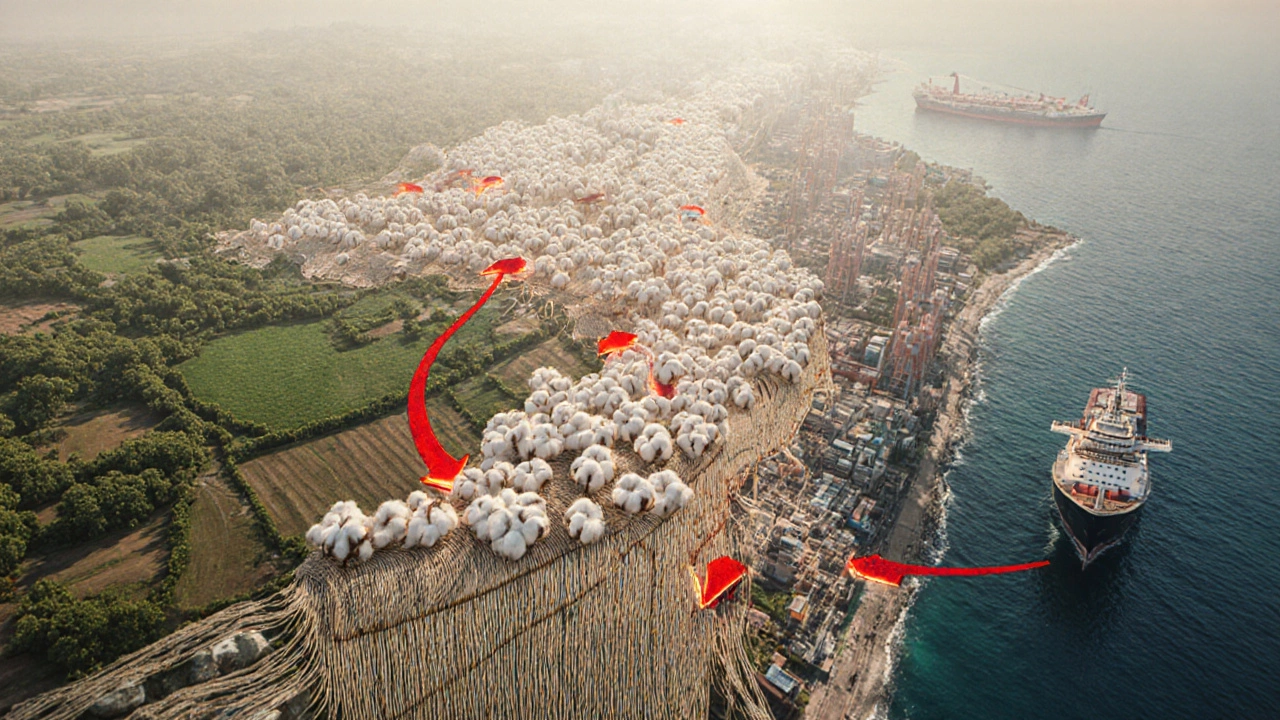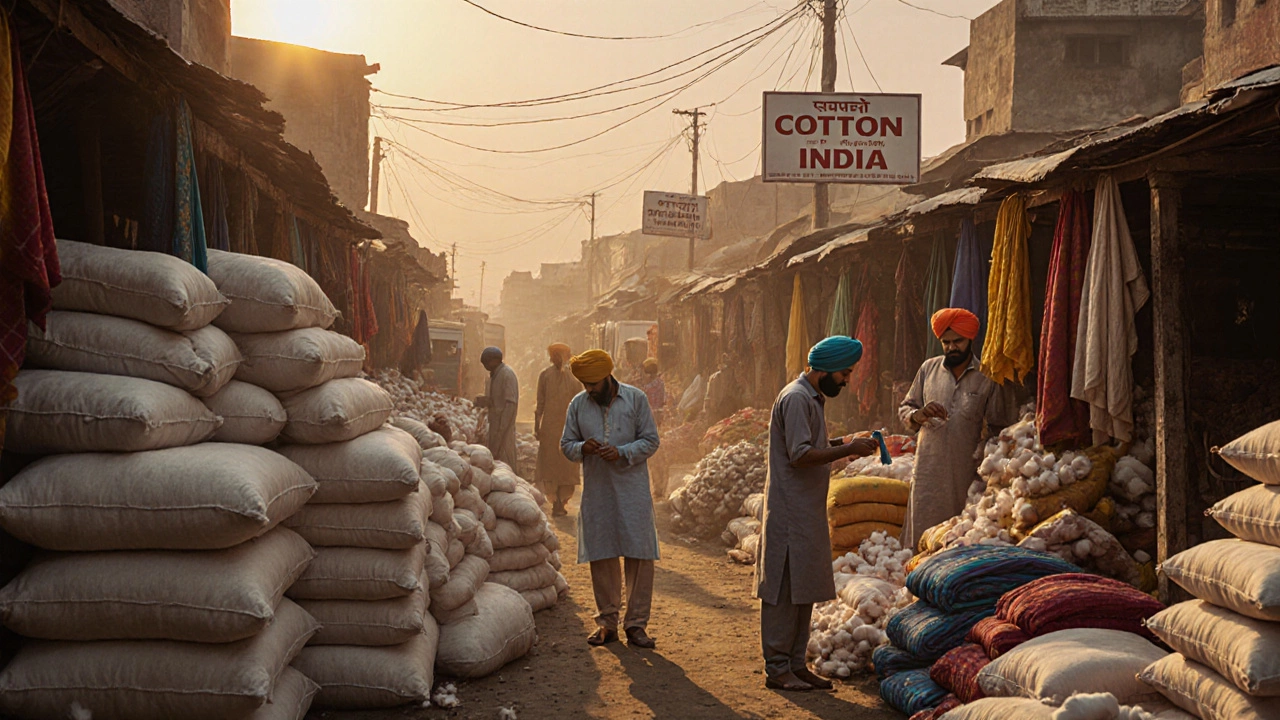Fabric Demand Calculator
India Fabric Demand Calculator
Based on latest data from the Cotton Corporation of India and textile industry reports
Fabric Demand Breakdown
India, 2025The essential fabric for daily wear, breathable, affordable, and culturally significant across all income levels
Fast fashion and workwear, often blended with cotton; growing but limited by climate suitability
Luxury fabric for special occasions; expensive and seasonal demand
Khadi, linen, wool, rayon, and other traditional or niche fabrics
Every year, India buys over 7 million tons of fabric. But not all cloth is created equal. Some types sell by the meter, others by the bale-and one stands out as the undisputed king of demand. If you’re looking at the Indian textile market in 2025, the answer isn’t fancy or exotic. It’s simple, everyday, and woven into the lives of nearly every Indian household: cotton.
Cotton Rules the Indian Wardrobe
Cotton isn’t just popular in India-it’s essential. Around 65% of all fabric consumed in India is cotton. That’s more than silk, polyester, wool, or any other fiber combined. Why? Because it breathes. Because it’s soft. Because it doesn’t stick to the skin in 40°C heat. And because it’s affordable for farmers, weavers, and families across rural and urban India.
States like Gujarat, Maharashtra, and Telangana grow the bulk of India’s cotton. But the demand doesn’t stop at the farm gate. From small-town tailors stitching kurtas to big brands like Reliance Retail and Tata Textiles, cotton is the backbone. Even in cities, where air conditioning is common, people still choose cotton for daily wear. A 2024 survey by the Cotton Corporation of India found that 8 out of 10 Indians own at least five cotton garments. That’s not a trend. That’s a habit.
Silk Still Has Its Place-But Not the Same Power
Silk is beautiful. Banarasi, Mysore, Chanderi-these names carry heritage. And yes, silk sales spike during weddings, festivals, and religious occasions. But silk doesn’t drive daily demand. It’s a luxury. It costs 5 to 10 times more than cotton per meter. A single silk saree can cost ₹8,000. A cotton one? ₹800.
Silk demand is seasonal and regional. It thrives in South India and parts of Uttar Pradesh. But even there, most women own just one or two silk pieces. Meanwhile, cotton is worn every day-by students, laborers, office workers, and grandmothers. The Indian textile industry produces over 4 billion meters of cotton fabric annually. Silk? Around 150 million meters. The gap isn’t close.
Synthetics Are Growing Fast-But Not Enough to Overtake Cotton
Don’t ignore polyester and nylon. They’re rising fast. Especially in fast fashion brands like Zara, H&M, and local players like Myntra and Ajio. Synthetic fabrics are cheaper to produce, wrinkle-resistant, and easy to dye. They’re popular in activewear, school uniforms, and workwear.
But here’s the catch: synthetics make up only about 28% of India’s total fabric consumption. And much of that is blended with cotton. Most ‘polyester’ shirts you see in Indian markets are actually 65% cotton, 35% polyester. Pure synthetics struggle in India’s climate. They trap heat. They cause rashes. They don’t absorb sweat. In a country where over 70% of the population lives in areas with high humidity and temperatures above 30°C for six months a year, comfort beats convenience.

Government Policies Favor Cotton
India doesn’t just rely on market forces. Government policies tilt the scale toward cotton. The Minimum Support Price (MSP) for cotton ensures farmers get a fair return. The Textile Promotion Scheme gives subsidies to cotton mills for modernizing equipment. The ‘Make in India’ initiative pushes local textile production over imports.
In 2023, the government allocated ₹1,800 crore to support cotton-based textile units. That’s more than what was spent on silk or synthetic fiber development. And it’s working. Cotton textile exports hit $14.2 billion in 2024-up 12% from the year before. China and Bangladesh may make more synthetics, but India still leads in cotton fabric exports.
What About Traditional Fabrics Like Khadi and Linen?
Khadi, hand-spun cotton promoted by Gandhi, has seen a revival. It’s trendy among urban millennials and eco-conscious buyers. But it’s still a niche. Khadi makes up less than 1% of total fabric demand. Linen is even smaller-mostly used in high-end fashion or for export to Europe. Neither comes close to cotton’s scale.
Even in the handloom sector, which employs over 4 million weavers, cotton is the primary fiber. The government’s ‘Weavers’ Service Scheme’ provides yarn, looms, and training-almost all of it for cotton-based production.

Why Other Fabrics Fall Short
Wool? Too expensive. Too hot. Used mostly in winter wear in northern hill stations. Jute? Used for sacks and bags, not clothing. Rayon? Often marketed as silk, but it’s a semi-synthetic that tears easily and shrinks in wash. None of these have the combination of affordability, comfort, durability, and cultural acceptance that cotton has.
Even in the medical and hospitality sectors, cotton dominates. Hospital gowns, bed sheets, towels-all made from cotton. Why? Because it’s hypoallergenic, washable at high temperatures, and doesn’t trigger skin reactions. That’s not a preference. That’s a requirement.
The Real Story Behind the Numbers
Let’s put this in perspective. In 2024, India produced 6.2 million metric tons of raw cotton. It imported only 180,000 tons. That’s because domestic supply meets 97% of demand. Compare that to polyester: India imports over 4 million tons of polyester fiber annually because it doesn’t grow enough to meet demand.
Cotton isn’t just a fabric. It’s an economic engine. It supports 60 million people-from farmers to spinners, weavers to retailers. It’s the thread connecting rural India to global markets. When you ask which cloth is most demanded in India, you’re not asking about fashion. You’re asking about survival, livelihood, and culture.
What’s Changing in 2025?
Organic cotton is growing. Brands like Fabindia and Arvind Limited are launching eco-friendly lines. But even here, it’s still cotton-just grown without pesticides. The demand isn’t shifting away from cotton. It’s evolving within it.
Smart textiles? Wearable tech? Those are still experiments. You won’t find a single Indian household wearing a sensor-integrated cotton shirt yet. But you’ll find millions wearing regular cotton shirts every morning.
India’s textile industry isn’t chasing trends. It’s meeting needs. And right now, that need is cotton.
Is cotton the most demanded fabric in India?
Yes, cotton is by far the most demanded fabric in India. It accounts for about 65% of total fabric consumption. Its popularity comes from comfort in hot weather, affordability, breathability, and cultural acceptance across all income levels.
Why isn’t silk more popular than cotton in India?
Silk is used mainly for special occasions like weddings and festivals, but it’s expensive-5 to 10 times the cost of cotton per meter. Most Indians own just one or two silk pieces, while cotton is worn daily. Cotton’s low cost, durability, and suitability for India’s climate make it the default choice.
Are synthetic fabrics like polyester replacing cotton in India?
Synthetics are growing, especially in fast fashion and uniforms, but they haven’t replaced cotton. Most ‘polyester’ clothes in India are actually cotton-polyester blends. Pure synthetics trap heat and cause skin irritation, making them unsuitable for daily wear in most parts of the country.
How much cotton does India produce and consume?
In 2024, India produced 6.2 million metric tons of raw cotton and consumed over 7 million tons. It imports only about 180,000 tons, meaning domestic production covers 97% of demand. India is one of the world’s largest cotton producers and consumers.
Does the Indian government support cotton production?
Yes. The government provides Minimum Support Price (MSP) to cotton farmers and allocates over ₹1,800 crore annually to modernize cotton textile units. Policies like Make in India and the Textile Promotion Scheme prioritize cotton-based manufacturing over imports or synthetics.
Is khadi or linen more popular than cotton?
No. Khadi is hand-spun cotton and makes up less than 1% of total fabric demand. Linen is used in niche markets and exports but is too expensive and limited in supply to compete with cotton. Both are popular for their heritage or eco-image, but not in volume.
